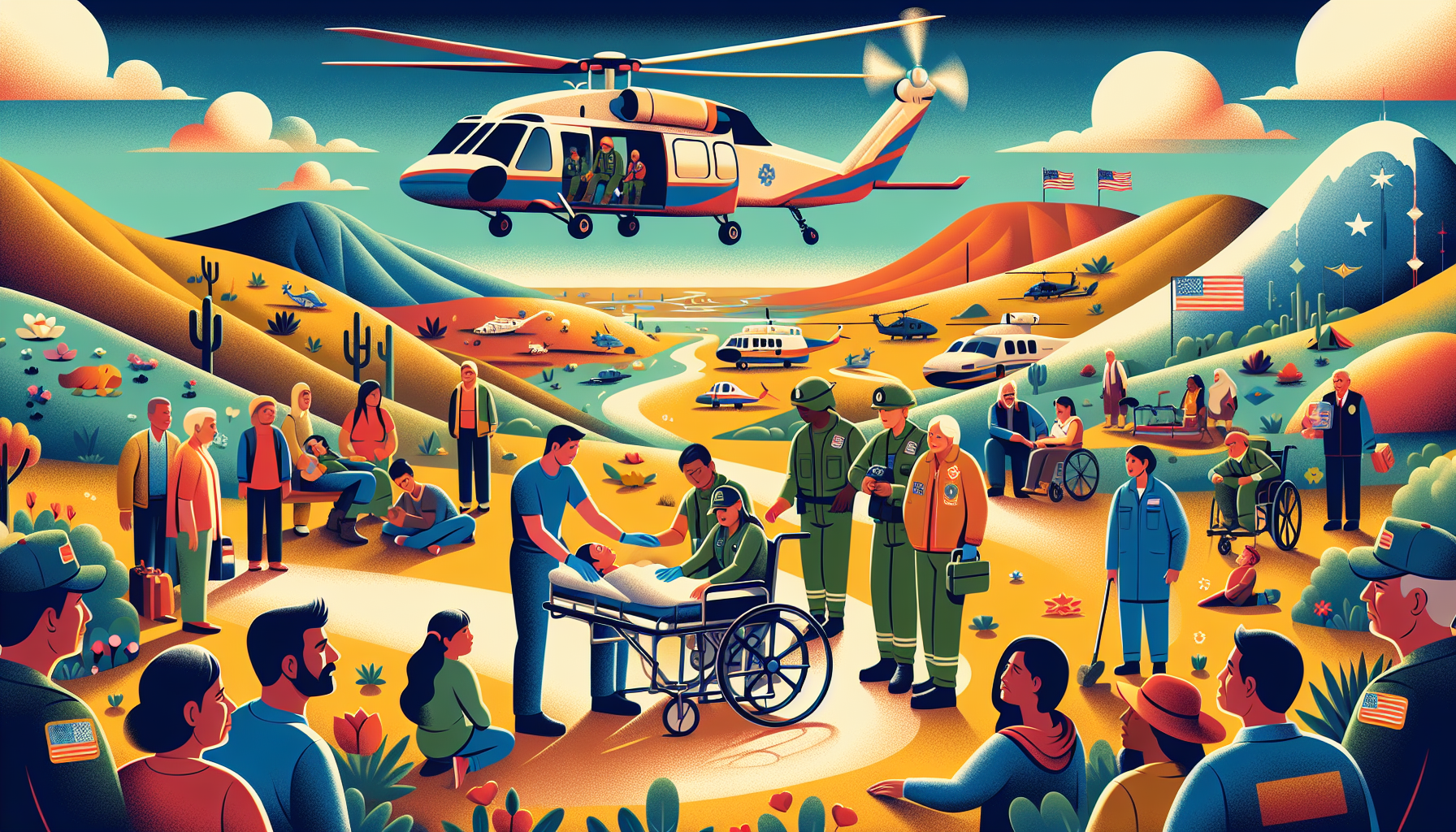Definition
An aeromedical evacuation unit is a specialized military unit responsible for transporting injured or ill personnel from the frontline or remote areas back to medical facilities. They utilize specifically designed aircraft equipped with medical equipment and staffed by trained medical personnel. Their primary objective is to provide swift and efficient medical care during transportation, increasing the chances of survival and recovery for the patients.
Key Takeaways
- Aeromedical evacuation units are specialized teams within the military responsible for transporting and providing medical care to injured or ill service members while being airlifted from remote or hostile locations to medical facilities.
- These units consist of highly trained medical personnel, including flight nurses, flight medics, and support crews who are equipped with the necessary skills and equipment to manage a wide range of medical conditions during air transportation.
- The primary goal of Aeromedical evacuation units is to provide lifesaving treatment and stabilize patients during transport, helping to reduce casualties and improve medical outcomes for injured soldiers, sailors, airmen, and marines.
Importance
The term “Aeromedical Evacuation Unit” is important in military operations as it refers to a specialized team responsible for providing timely and efficient transportation of patients from the site of combat or natural disaster to designated medical facilities.
As a crucial component of medical support and overall mission success, these units play a vital role in streamlining patient care and optimizing the recovery process.
By utilizing air assets, such as helicopters and fixed-wing aircraft, aeromedical evacuation units enable rapid response, which can be the difference between life and death in critical situations.
Furthermore, the expertise of the medical personnel within these units ensures that patients receive the highest level of care during transit, thus maximizing the chances of saving lives and preserving the health of service members and civilians alike.
Explanation
Aeromedical evacuation units play a critical role in military operations by providing prompt and efficient transportation of casualties from the battlefield to medical facilities that can administer specialized treatments. These units not only improve the survival rate of wounded military personnel, but they are also essential in maintaining the morale of deployed troops who gain reassurance in knowing that, if they are injured, they would receive prompt medical attention.
In addition, aeromedical evacuation units offer support during humanitarian crises, contributing to the overall mission of the armed forces by delivering aid and relief efforts to affected populations across the globe. One of the primary functions of aeromedical evacuation units is to dramatically reduce the time between injury and treatment, a crucial factor in preventing fatality.
To achieve this, specialized aircrafts, outfitted with the necessary medical equipment and skilled healthcare professionals, are utilized to rapidly transport casualties to medical facilities with the capability to provide the required level of care. In this context, aeromedical evacuation units are an essential component of a comprehensive military healthcare system, ensuring that troops receive expedited medical attention regardless of their location or the scope of their injuries, further exemplifying the commitment of the military to protecting its personnel and contributing to a greater sense of unity and cohesion among the fighting forces.
Examples of Aeromedical evacuation unit
Operation Desert Storm (1991):During the Gulf War, the U.S. military’s aeromedical evacuation units played a vital role in transporting injured personnel from the battlefields to hospitals or medical facilities for immediate treatment. Specifically, the 2nd Aeromedical Evacuation Squadron was tasked with evacuating injured soldiers and transporting them to safer locations where they could receive medical attention.
2010 Haiti Earthquake:Following the devastating earthquake in Haiti in 2010, the U.S. Air Force’s 375th Aeromedical Evacuation Squadron, along with other international military units, worked tirelessly to evacuate injured civilians and deliver much-needed medical supplies to the affected areas. In the aftermath of the earthquake, these units were instrumental in providing critical care to thousands of injured people and saving countless lives.
Operation Enduring Freedom (Afghanistan, 2001-Present):Throughout the ongoing conflict in Afghanistan, aeromedical evacuation units such as the U.S. Air Force’s 455th Expeditionary Aeromedical Evacuation Squadron have played a crucial role in evacuating injured soldiers from the battlefield to hospitals or medical facilities. These specially trained units are responsible for ensuring the safe and timely arrival of injured personnel to locations where they can receive proper medical care, often flying through dangerous and hostile conditions.
Aeromedical Evacuation Unit FAQ’s
1. What is an Aeromedical Evacuation Unit?
An Aeromedical Evacuation Unit (AEU) is a specialized military unit responsible for the transportation and care of patients who are injured or critically ill during wartime or disaster relief operations. The AEU uses specially equipped aircraft to safely and efficiently transport patients to medical facilities for further treatment.
2. What type of aircraft do AEUs use?
AEUs often use cargo planes such as the C-130 Hercules or the C-17 Globemaster III, which can be configured to transport several patients at once. Additionally, AEUs might use helicopters like the UH-60 Blackhawk or the CH-47 Chinook, for shorter distances and more difficult terrains.
3. What type of medical personnel are in the Aeromedical Evacuation Unit?
AEUs typically consist of a mix of medical professionals such as flight nurses, flight medics, and respiratory therapists. These personnel are trained to handle the unique challenges and needs of patients in flight and to maintain a high standard of care throughout the aeromedical evacuation process.
4. How are patients transported within the aircraft?
Patients are placed on specialized litters (stretchers), equipped with restraint systems, medical equipment, and monitoring devices. These litters are then secured onto the aircraft in a precise manner, ensuring patient safety during takeoff, landing, and any potential turbulence en route.
5. In what situations are Aeromedical Evacuation Units deployed?
AEUs are called upon in a variety of situations, including combat operations, natural disasters, and humanitarian missions. Their capabilities are essential for providing rapid medical care and transport to injured or ill individuals in remote or difficult-to-reach areas.
6. How do AEUs coordinate with other medical units and facilities?
The AEU works in close coordination with other military medical units, civilian medical facilities, and government organizations to ensure a seamless transfer of care. Through effective communication and partnerships, the AEU ensures patients receive the appropriate level of care upon arrival at their destination.
Related Military Operation Terms
- Air Ambulance
- Medical Evacuation (Medevac)
- Flight Nurse
- Critical Care Air Transport Team (CCATT)
- Evacuation Chain
Sources for More Information
- U.S. Air Force Air Mobility Command
- U.S. Department of Defense – Defense Health Agency
- U.S. Army Aeromedical Evacuation Officer
- Wikipedia – Aeromedical Evacuation
 Benefits.com Advisors
Benefits.com Advisors
With expertise spanning local, state, and federal benefit programs, our team is dedicated to guiding individuals towards the perfect program tailored to their unique circumstances.
Rise to the top with Peak Benefits!
Join our Peak Benefits Newsletter for the latest news, resources, and offers on all things government benefits.




















